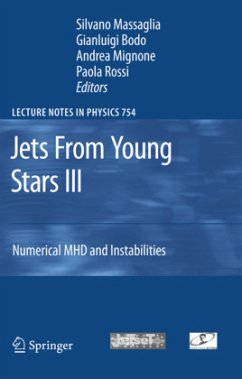The study of the mechanisms that govern origin and propagation of stellar jets involves the treatment of many concurrent physical processes such as gravitation, hydrodynamics and magnetohydrodynamics, atomic physics and radiation. In the past years, an intensive work has been done looking for so- tions of the ideal MHD equations in the steady state limit as well as studying the stability of out?ows in the linear regime. These kind, of approaches have provided a contribution to the understanding of jets that can hardly be ov- estimated. However, the extension of the analyses to the time-dependent and nonlinear regimes could not be avoided, and the MHD numerical simulations were the only mean to achieve this goal. Intherecentyears,considerableprogresseshavebeenmadebythecom- tational?uiddynamiccommunityinthedevelopmentofnumericaltechniques, theso-calledhighresolutionshockcapturingschemes,wellsuitedforthetre- ment of supersonic ?ows with discontinuities. The numerical simulations of astrophysical jets took advantage of these developments; however new physics needed to be incorporated, such as magnetic ?eld e?ects, radiation losses by diluted gases, and proper astrophysics environments. These needs led to the nontrivial extension of the methods devised for the Euler equations of g- dynamics to the magneto-hydrodynamical system. On the other hand, the possibility of carrying out numerical calculations has been greatly facilitated bytheavailability, ononehand,ofpowerfulsupercomputersand,ontheother hand, of fast processors at low cost. Large scale 3D simulations of jets at high resolution are now possible thanks to supercomputers, but also high reso- tion 2D MHD simulations can be performed routinely on desktop computers.








